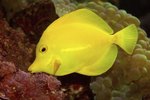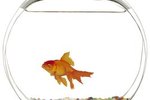
Plecos are an ideal addition to any freshwater aquarium due to their ability to clean algae from the tank. A poor understanding of this species can lead to malnutrition and even death. As a responsible owner, it's your job to learn the facts about plecos so that you provide the best care possible.
About
The plecostomus is native to South America and is a member of the catfish family. Their mouths have adapted as a survival feature that allow them to attach to rocks in the swift moving streams where they can be found. In captivity, plecos use their mouths to attach to the sides of the tank where algae collects. The pleco will work its way around the tank, sucking your tanks walls clean.
Characteristics
The common pleco can grow up to 2 feet long. As a nocturnal species, the pleco has the ability to shut out light with its omega iris. When the lights go out, the pleco opens the iris and begins to search for food. Plecos are hardy fish that have a hard plate exterior as well as a spiny fin to protect them from other fish.
Diet
People often are mistaken that a pleco can live on the algae that gathers in the tank. A full-grown pleco would need a huge tank to provide enough nourishment from tank algae alone. Not providing enough food sources will lead to malnourishment and even death. Plecos can eat algae wafers, shrimp pellets and leafy green vegetables. They also enjoy the occasional treat of bloodworms and can be fed par-boiled vegetables, such as zucchini.
Habitats
During the warm months of the year, plecos can live in outdoor ponds. In the winter, the pleco will need to be brought inside. The ideal temperature range for this species is 72 to 79 degrees Fahrenheit. When housed inside, you always want to have a lid on your tank as plecos are excellent jumpers. Your tank should be 50 to 100 gallons in size to house a full-grown pleco and should be densely packed with plants to provide hiding areas for the fish.
Tank Mates
Plecos do well with most fish, except their own species. It should be noted that plecos often like to suck on flat or fat bodied fish, such as goldfish. For the safety of your fish, you should avoid housing these fish with plecos.
References
Photo Credits
-
Jochen Sands/Photodisc/Getty Images
Writer Bio
Amy Brantley has been a writer since 2006, contributing to numerous online publications. She specializes in business, finance, food, decorating and pets.




